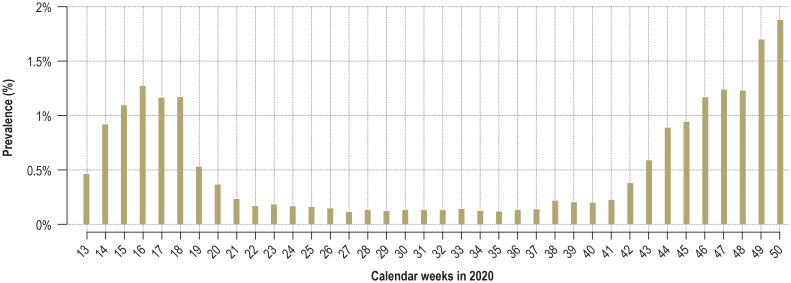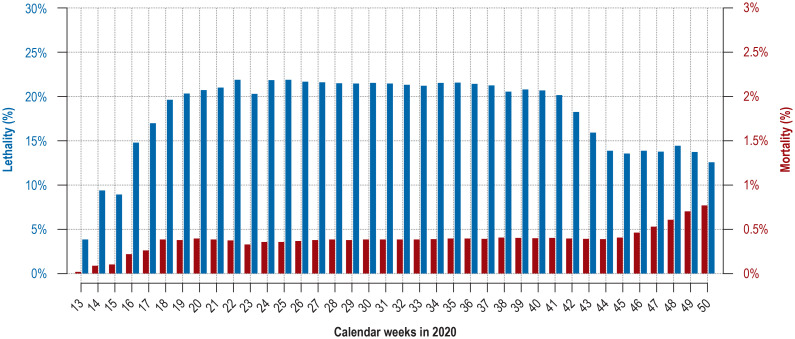Already in the early phase of the COVID-19 pandemic, a high rate of acute kidney failure was described in patients with severe disease progression, with or without previous kidney diseases (1). The fact that chronic kidney disease and, in particular, long-term dialysis are among the risk factors for severe COVID-19 cases has been confirmed by registry studies from Europe and Canada, which report a COVID-19 lethality of 20%–30% in dialysis-dependent patients (DDP) (2, 3). Here we present the corresponding data from a nationwide register initiated by the German Society for Nephrology (Deutsche Gesellschaft für Nephrologie, DGfN) in March 2020.
Acknowledgments
Translated from the original German by Veronica A. Raker, PhD.
Acknowledgements
The authors would like to thank all colleagues from the 238 dialysis centers for their excellent collaboration. The authors would like to thank Nicola Wanner (Hamburg) for support in creating the manuscript graphics, and Samaneh Liagos (Hamburg) for entering the data on a weekly basis. The study was supported by the SFB 1192.
Footnotes
Conflict of interest statement The authors declare that no conflict of interest exists.
Methods
COVID-19 Register of the DGfN
Weekly questionnaires were used to collect:
Number of patients permanently requiring dialysis treated in dialysis centers (for hemodialysis as well as peritoneal dialysis patients);
Number of long-term DDPs with current SARS-CoV-2 infection in outpatient, inpatient, or intensive care;
Number of long-term DDPs who recovered or died after SARS-CoV-2 infection.
The weekly standardized data collection and analysis took place descriptively from March 2020 to the end of December 2020. Each week, the following cumulative measurements were estimated across all centers:
Prevalence (number of active COVID-19 cases divided by the number of patients requiring dialysis);
Lethality (number of deaths reported up to the week evaluated, divided by the number of all COVID-19 cases. The number of all COVID-19 cases was calculated as the sum of active cases in that week, as well as patients who had died or recovered that week);
Mortality (number of deaths divided by DDP number);
Recovery rate (number of recovered patients divided by the number of all COVID-19 cases, analogous to lethality).
All of the above measures relate to the patients in the reporting dialysis centers, and not to all DDPs in Germany. The centers did not report the data in full for all weeks. For the dimensions described above, analysis was based on the “actual” data as well as on replaced missing values; this was limited to the period between the first and last weeks in which the respective center provided data. The “last observation carried forward (LOCF)” method was used, which assumes that there were no changes as compared to the previous week.
Results
An average of 11588 hemodialysis patients from across Germany were recorded each week (around 12% of the total of about 95000 DDPs). In spring 2020, the COVID-19 prevalence rose to approximately 1.4% of DDPs in April and then fell continuously over the summer (figure 1). Of the DDPs with COVID-19, about 20% died by May 2020; in other words, 0.4% of all DDPs died of or with COVID-19 during this time (figure 2). The rise in lethality came after the rise in disease prevalence. The recovery rate of COVID-19–positive DDPs reached about 70% in May 2020. The results of the prevalence and lethality/mortality were not significantly different with or without LOCF replacement of missing values (with a mean of 18.7% missing values in the patient data). The disease prevalence rose again in autumn, reaching almost 2% in December 2020. The lethality and recovery rate for DDPs with COVID-19 in relation to the total number of DDPs with COVID-19 were constant over the summer and fell in autumn (figure 2). At the same time, there was a clear increase in the mortality in DDPs with COVID-19, based on the total number of all DDPs, reaching almost 0.8% (figure 2).
Figure 1.
COVID-19 prevalence in long-term DDPs in every calendar week (with LOCF replacement of missing values)
DDP, dialysis-dependent patients; LOCF, last observation carried forward
Figure 2.
Lethality of DDPs with COVID-19 (based on the number of DDPs with COVID-19; blue) and mortality of DDPs with COVID-19 (based on the total number of DDPs reported weekly; red); analyses were carried out for each calendar week (with LOCF replacement of missing values).
DDP, dialysis-dependent patients; LOCF, last observation carried forward
Discussion
The approximately 20% lethality in patients permanently requiring dialysis with COVID-19 in Germany is very high, yet is on a level comparable to that of other industrialized nations (2, 3), and corresponds to the highest risk category in Germany with regard to COVID-19 (comparable to that of people over 80 years old).
Thus, preventive measures are particularly important for patients who require dialysis. In the course of 2020, considerable efforts were made in the dialysis centers to implement new and expanded hygiene rules. Nevertheless, a significant increase in the number of cases was not avoided in the second wave of the pandemic. This is certainly due to the fact that patients requiring dialysis cannot remain in quarantine at home, but are generally exposed to an increased risk three times a week due to patient transport and contact with other patients and staff. A significant improvement can only be achieved by quickly vaccinating these patients against COVID-19. Patients requiring dialysis should therefore be vaccinated as a priority.
References
- 1.Cheng Y, Luo R, Wang K, et al. Kidney disease is associated with in-hospital death of patients with COVID-19. Kidney Int. 2020;97:829–838. doi: 10.1016/j.kint.2020.03.005. [DOI] [PMC free article] [PubMed] [Google Scholar]
- 2.Ortiz A. Chronic kidney disease is a key risk factor for severe COVID-19: a call to action by the ERA-EDTA. Nephrol Dial Transplant. 2021;36:87–94. doi: 10.1093/ndt/gfaa314. [DOI] [PMC free article] [PubMed] [Google Scholar]
- 3.Taji L, Thomas D, Oliver MJ, et al. COVID-19 in patients undergoing long-term dialysis in Ontario. CMAJ. 2021;193:E278–E284. doi: 10.1503/cmaj.202601. [DOI] [PMC free article] [PubMed] [Google Scholar]




